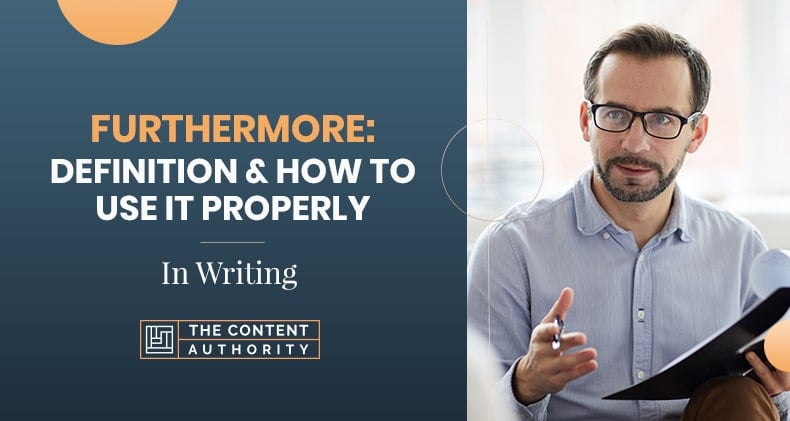For avid readers, nothing can be more annoying than reading a book or an article where the use of a conjunctive adverb, such as “furthermore”, is incorrect or the word has been thrown in randomly just to vary the flow of the text. When the word is used to conjoin unrelated sentences, the reader may find the blatant error repulsive and would lose interest in the prose. And it’s even worse when the word is not used when it should have been used.
The word “furthermore” brings together two sentences that have a connection, to begin with. It works like “also”, except it’s used to advance an argument. When listing reasons for an argument, you start with listing the first reason. When introducing the other reason, you use “furthermore” to precede it.
“Furthermore” is a handy word when the need to make an additional point arises in an explanation or argument. However, when used incorrectly, it could completely throw off a series of sentences or the entire paragraph. Keep reading to learn more about the word and how to use it correctly.

Defining Furthermore
First used in the 13th century, “furthermore” is a conjunctive adverb that indicates there is something more to be said in a group of text or speech in addition to what’s already being said. It’s a transitional word – such as “however”, “and”, and “thus” – that ties sentences, paragraphs, and thoughts together.
It’s a word that helps append or link a sentence with more and related information to an existing sentence. The additional information in the second, third, or the sentences thereafter is equally important, if not more, as the original sentence.
The word “furthermore” communicates a sense of creation or building. It is typically used at the starting of a sentence, with a comma immediately following it. As soon as the word shows up in or after a sentence, it’s a sign that the writer or author is not done with what they want to say. The word indicates the author or speaker has a thought of reasoning, which they are furthering using additional evidence.
Though used in both formal and informal correspondences, the word “furthermore”, like most conjunctive adverbs, is not commonly used in everyday speech. However, it shows face in written prose quite frequently.
Furthermore Synonyms
“Furthermore” could be interchanged with words such as “in addition” and “moreover”. If you have to use the word multiple times in a para or manuscript, you may use these words. Besides the two, you could use a few more synonyms, which include:
- Additionally
- Also
- Again
- Either
- Besides
- Likewise
- Moreover
These synonyms may not have the same effect as “furthermore”, however. For instance, the words “in addition” has a more neutral tone or is not as assertive an expression as “furthermore”. The former is typically used to add a single piece of information relating to the subject.
The word “furthermore”, on the other hand, is a lot more empathetic. Though it too adds a piece of data, it does send a stronger signal as if it wants to say to the reader or listener, “Don’t go already, for I am not done yet.”
Though not commonly used in lieu of “furthermore”, these are some other synonym words/phrases for the conjunctive adverb:
- By the same token
- Over and above that
- On top of that

How to Use the Word “Furthermore” Properly
Before you learn how “furthermore” should be properly used in texts, here are a few example sentences to get familiar with the word in sentences:
- I like the color blue. Furthermore, I like green.
- The camera is great. Furthermore, it’s quite inexpensive.
- I am not sure what happened to Maria. Furthermore, I just don’t care.
- All residents of the building were advised to evacuate. Furthermore, they were instructed to not return to their abodes until an official announcement was made.
- We furthermore won’t allow people acting weirdly to continue posting on our page.
- And the more data we accumulate, it’s starting to look as if there was just no need to put the brakes on the economy. And, furthermore, it’s certainly not how the economy would be able to revive itself.
Removing the sentence or phrase after the word “furthermore” could alter or change the message of the sentence(s). In the first bullet point above, the first sentence throws light on the camera’s prowess. And the sentence right after it provides equally important information about the cost of the camera.
As mentioned earlier, “furthermore” helps link sentences. Here are a couple of lines with multiple sentences. The first line of sentences has no “furthermore” in it and, therefore, reads a bit choppy. And with the inclusion of “furthermore”, the line of texts becomes more readable.
- You are a good person. You do not lie. You do not cheat. You do not steal.
When you throw in a “furthermore” here along with the conjunction “and”, the sentences flow and are tied together better.
- You are a good person. You do not lie and do not cheat. Furthermore, you do not steal.
The word “furthermore” need not always inaugurate a sentence. It could be used in the same sentence somewhere in the middle, such as:
- I am not interested in your service, and furthermore, I requested your customer service team to not get in touch with me regarding the same.
- The property is located in one of the poshest communities in the town; furthermore, it is close to a Walmart store.
The word “furthermore” should usually bring together a couple of sentences. If the two sentences, however, could stand by themselves as individual sentences, it typically denotes “furthermore” has been misused or not correctly placed. To save face, you could put in a semicolon or a period before “furthermore”.
Here are a couple of sentences with the word – one having got the usage wrong and the other having used the word correctly:
- Michael Jackson is a songwriter, singer, dancer, and philanthropist, furthermore, he is the greatest entertainer of all time. (incorrect)
- Michael Jackson is a songwriter, singer, dancer, and philanthropist; furthermore, he is the greatest entertainer of all time. (correct)

The Similarities/Differences Between “Furthermore” and “Moreover”
Like “furthermore” and most of its synonyms, the word “moreover” tries to persuade the listener or reader of something, adding to the current argument with additional supports. Unlike “in addition to” and like “furthermore”, “moreover” has a more authoritative or forceful tone and could, therefore, be chosen to bolster an argument.
Here are some example sentences with the word “moreover”:
- I do not think he is an overrated singer. Moreover, I feel you are simply jealous of his talent.
- His resigning doesn’t surprise me one bit. He has been giving the “vibes” for a few weeks now. Moreover, he has been attending interviews during the weekends.
The original sentence in the first example provides a statement of thought/opinion. The sentence starting with “moreover” provides one more statement. Similar is the case with the second example.
Due to their authoritative tones or assertiveness, the words “furthermore” and “moreover” generally get used in fiery speeches and heated arguments more than more neutral expressions. It’s not that difficult to hear these words when an instructor or school principal is reprimanding students for their unacceptable conduct.
- Your deplorable actions toward her will be duly accounted for, and, moreover, you must apologize to her and her parents.
- I will no more accept late comers into the class. Furthermore, students coming late to class will have to bring their parents to school the next day.
If you were to look for differences in inflection and impact on prose between “furthermore” and “moreover”, you could possibly say “moreover” takes the conversation to a tier just above “furthermore”. Like “furthermore”, the inclusion of the word “moreover” also indicates the argument is being taken forward.
However, with “moreover”, the reader gets a sense (or at least what the speaker or the author should intend to) the advancement in the argument is taking a slightly different trajectory, which is different fundamentally but leads to the same conclusion.
Despite these minor differences, the words “furthermore” and “moreover” are quite interchangeable, and it won’t be grammatically wrong to use one word in place of another. If the need to use the words arises in the same paragraph, you may alternate between the two. And when doing so, make sure you use “moreover” first and then use the word “furthermore”.
Conclusion
The word “furthermore” is a transition word that makes comprehending a manuscript or speech easier. This is provided the word is being placed correctly and only when it is needed. When it’s used merely for embellishment reasons or when there is no real need to use the word, usage of the word would only hinder the flow and impact the meaning of the sentence.
According to certain schools of thought, a transitional word such as “furthermore” may be verboten or considered fluff. With most styles of writing, however, that isn’t the case. If the word helps to carry on a particular thought in a paragraph a lot more coherently, go ahead and use the word.
Shawn Manaher is the founder and CEO of The Content Authority. He’s one part content manager, one part writing ninja organizer, and two parts leader of top content creators. You don’t even want to know what he calls pancakes.

